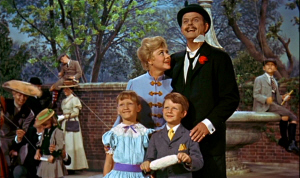The traditional idea of success and happiness was rooted in to the conservative ideal of the American family structure of the “Breadwinning father, stay-at-home mother and children.” By the 1960s, this was beginning to change. An article written by Anne McLeer: http://muse.jhu.edu/journals/nwsa_journal/v014/14.2mcleer.pdf about two pop culture 1960s movies “The Sound of Music” and “Mary Poppins” discusses how these films attempt to restore these conservative ideals. Both films reinforce the conservative American family structure with nanny figure. The nanny represents one side of the contemporary facet of women hood, while the counterpart relies on traditional ideals by searching for a husband The nannies in these films bring balance into their households and remind women that their most satisfying role is in their homes. In AMC’s “Mad Men,” Peggy is an allegory to this nanny figure because it is her duty as Don Draper’s secretary to maintain order in his life. In the second episode of the first season, Peggy is forced to entertain Don’s wife Betty and their children while reassuring them that Don will return shortly for the family portrait. It’s Peggy’s job to instill balance in the Draper household while her independent role reminds Betty the importance of being married to a man with status like Don. Ultimately, Peggy serves as a “mentor” to Betty and reminds her of the “purity and simplicity of womanhood.”
Both films also bring to light the role of the father in the household. The paternal characters are seen as the disciplinarians before the nannies arrive. In “Mary Poppins,” George Banks believes he has everything under control in his personal and professional life, despite his rocky relationship with his wife. His patriarchal role is atrophied by his spouse’s feminism and his children’s rejection of disciplinary values. Similar to George’s situation, Don falsely believes he has everything under control in his household. Betty struggles with her anxiety attacks and can hardly care for her two children. Betty capriciously acts out in an attempt to lure her husband back into her life. She tells her therapist that she knows her husband is cheating on her in order to get Don’s attention. Betty acts like a child in order to get any type of attention from her husband.
Image Credit: http://www.google.com/imgres?imgurl=http://www.fromscripttodvd.com/images/Mary%2520Poppins%2520DVD/Family%2520Banks%2520smaller.jpg&imgrefurl=http://www.fromscripttodvd.com/mary_poppins_dvd_review.htm&usg=__ir_urfep6kJLzzKVfH6FlILrwXE=&h=178&w=300&sz=60&hl=en&start=0&zoom=1&tbnid=MPiisRtDvsw2xM:&tbnh=134&tbnw=179&ei=8_xjTafYMYH78AaVk5XnCw&prev=/images%3Fq%3Dgeorge%2Bbanks%2Bmary%2Bpoppins%26um%3D1%26hl%3Den%26client%3Dsafari%26sa%3DX%26rls%3Den%26biw%3D1234%26bih%3D737%26tbs%3Disch:1&um=1&itbs=1&iact=hc&vpx=475&vpy=103&dur=4119&hovh=142&hovw=240&tx=180&ty=51&oei=8_xjTafYMYH78AaVk5XnCw&page=1&ndsp=25&ved=1t:429,r:2,s:0
Image Credit: http://www.google.com/imgres?imgurl=http://www.fromscripttodvd.com/images/Mary%2520Poppins%2520DVD/Family%2520Banks%2520smaller.jpg&imgrefurl=http://www.fromscripttodvd.com/mary_poppins_dvd_review.htm&usg=__ir_urfep6kJLzzKVfH6FlILrwXE=&h=178&w=300&sz=60&hl=en&start=0&zoom=1&tbnid=MPiisRtDvsw2xM:&tbnh=134&tbnw=179&ei=8_xjTafYMYH78AaVk5XnCw&prev=/images%3Fq%3Dgeorge%2Bbanks%2Bmary%2Bpoppins%26um%3D1%26hl%3Den%26client%3Dsafari%26sa%3DX%26rls%3Den%26biw%3D1234%26bih%3D737%26tbs%3Disch:1&um=1&itbs=1&iact=hc&vpx=475&vpy=103&dur=4119&hovh=142&hovw=240&tx=180&ty=51&oei=8_xjTafYMYH78AaVk5XnCw&page=1&ndsp=25&ved=1t:429,r:2,s:0

By 1960, it was a widely circulated belief that a man’s position in his household as the main provider was being eroded by women’s employment. Fathers in pop culture also tried to reestablish their role in their houses that the male is the provider and tried to ensure their children emotional security. An example of this is when Don wakes his young son Bobby up at the middle of the night and tells Bobby that he can always know that he is being truthful to him.
Image Credit: http://www.google.com/imgres?imgurl=http://images.wikia.com/madmen/images/a/aa/Peggyolson3.jpg&imgrefurl=http://madmen.wikia.com/wiki/Top_10_list:Why_We_Love_Peggy_Olson&usg=__IK1Jvk3X8YkQPTQe2ue-ujk6f1k=&h=300&w=400&sz=32&hl=en&start=0&zoom=1&tbnid=qIbwKJLXFffejM:&tbnh=142&tbnw=184&ei=9fpjTb6mLoG_gQfzwtDmAg&prev=/images%3Fq%3DPeggy%2BOlson%26um%3D1%26hl%3Den%26client%3Dsafari%26sa%3DX%26rls%3Den%26biw%3D1234%26bih%3D737%26tbs%3Disch:1&um=1&itbs=1&iact=hc&vpx=319&vpy=81&dur=2867&hovh=194&hovw=259&tx=106&ty=77&oei=x_pjTfCTEcH-8AaZ89HfCw&page=1&ndsp=27&ved=1t:429
Image Credit: http://www.google.com/imgres?imgurl=http://images.wikia.com/madmen/images/a/aa/Peggyolson3.jpg&imgrefurl=http://madmen.wikia.com/wiki/Top_10_list:Why_We_Love_Peggy_Olson&usg=__IK1Jvk3X8YkQPTQe2ue-ujk6f1k=&h=300&w=400&sz=32&hl=en&start=0&zoom=1&tbnid=qIbwKJLXFffejM:&tbnh=142&tbnw=184&ei=9fpjTb6mLoG_gQfzwtDmAg&prev=/images%3Fq%3DPeggy%2BOlson%26um%3D1%26hl%3Den%26client%3Dsafari%26sa%3DX%26rls%3Den%26biw%3D1234%26bih%3D737%26tbs%3Disch:1&um=1&itbs=1&iact=hc&vpx=319&vpy=81&dur=2867&hovh=194&hovw=259&tx=106&ty=77&oei=x_pjTfCTEcH-8AaZ89HfCw&page=1&ndsp=27&ved=1t:429
 Even though conservative perspective dominated the films messages, both movies portray Mary Poppins and Maria from “The Sound of Music” as liberated because both are opinionated, independent and are willing to defend their values, even if it means defying their male employer. Peggy is similar to these women because while she does not defy Don, she decries the social order of the era by working and living autonomously in the city. Peggy works for herself and soon attains a prestigious job as the first female copy right for Sterling Cooper. The purpose of these films was to address the rapidly changing gender roles of the 1960s and the changes the male centric attempts to make in an effort to reassert his traditional role in the family.
Even though conservative perspective dominated the films messages, both movies portray Mary Poppins and Maria from “The Sound of Music” as liberated because both are opinionated, independent and are willing to defend their values, even if it means defying their male employer. Peggy is similar to these women because while she does not defy Don, she decries the social order of the era by working and living autonomously in the city. Peggy works for herself and soon attains a prestigious job as the first female copy right for Sterling Cooper. The purpose of these films was to address the rapidly changing gender roles of the 1960s and the changes the male centric attempts to make in an effort to reassert his traditional role in the family.


Interesting article, providing justification for your claims.
ReplyDelete